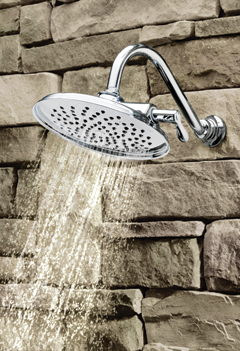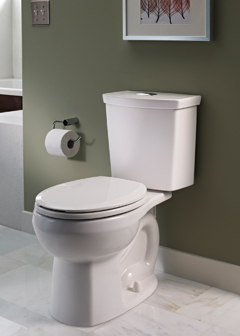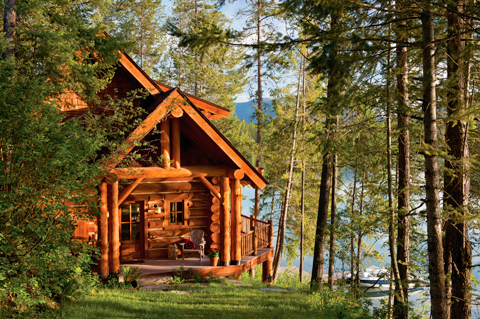With energy costs on the rise, it’s not just environmentally friendly to keep your energy consumption reined in—it’s wallet-friendly too! And the best time to consider your energy savings is when you’re building a new home.
If you plan appropriately, it’s possible to build a “zero-net energy” log home. Also called “energy neutral” or “net zero,” zero-net energy (ZNE) homes actually collect or produce more energy than they use, making it possible to live independently from the energy grid. “A zero-net energy building reduces the overall use of energy with extremely efficient building products, materials, and appliances,” says Karen Thull, interim executive director of the Energy & Environmental Building Alliance. “Everything from HVAC and lighting technologies, to the selection of insulation, windows, water fixtures, paint, flooring, and appliances is thoughtfully planned and designed to create a zero energy building.”
Think in terms of two facets: (1) the overall efficiency of your home, and (2) your sources of energy. Ideally, you want a home that consumes as little energy as possible and you want the energy you consume to be clean and renewable. Here are a few ways to implement zero-net energy principles into your own log home.

@2012 Moen Incorporated
Go Smaller
First things first: consider your footprint. Do you really need all that space? Big, open homes are beautiful and dramatic, but they also present heating and cooling challenges and use more resources to build. If you can get away with a smaller house that makes the most of every inch of living space, you’ll end up with a more efficient home.
Get Help
Find a builder that has experience with energy-efficient building practices and is open to your ZNE goals. Do a little research online before you get started. The U.S. Department of Energy has extensive resources available to homeowners on its website, including incentives, tax rebates, and financing information.
Materials
Your building choices will have an enormous impact on your home’s energy efficiency. Windows and insulation are two areas where it’s critical to use high-quality materials if you want to keep your home warm all winter and cool in the summer.
Consider installing a “cool” roof. Made of highly reflective paint, tiles, or shingles, a cool roof is designed to reflect sunlight and absorb less heat than a standard roof. You can lower the temperature of your roof by up to 50 degrees Fahrenheit, which means you won’t use as much energy on air conditioning.
Passive Solar
Log homes are naturally energy efficient buildings, due to the logs’ ability to absorb and slowly release heat, but implementing passive solar principles to your design will also help keep your home’s temperature stable year-round and reduce the need for additional heating and cooling.
Use design and materials to take advantage of the sun’s warmth in the winter while reducing exposure in the summer. You can also incorporate fans and overhangs to help keep temperatures stable.
Landscaping is another passive solar way to lower your energy bills. Strategically placed trees can provide shade and protect your home from wind, keeping it cooler in the summer and warmer in the winter.
Appliances
Choose Energy Star®-rated appliances throughout your home. With new lighting standards in effect this year, more efficient incandescent, fluorescent, and LED light bulbs are available that will save considerably on energy consumption—up to 75 percent. Install low-flow showerheads and faucets, and consider an on-demand or tankless water heater.

@ 2012 American Standard
Clean Power
Going completely off-grid may not be realistic for you, but you can certainly supplement your power with clean and renewable energy sources such as solar, geothermal, or wind power. Renewable energy sources are becoming increasingly affordable to install and are highly reliable. In fact, the photovoltaic (solar) systems installed at Walt Disney’s Epcot Center in 1982 have survived a number of hurricanes and are still going strong!
Evaluate your site to figure out whether these renewable power options will work for you. For wind turbines, you should be in a rural area with at least an acre of land, and have average wind speeds of 10 miles per hour to make the expense of installation worthwhile. Wind electric systems can lower your utility bills by as much as 50-90 percent, so it’s an option worth investigating!
Solar (or photovoltaic) systems are most cost-effective in areas where they can be used throughout the year, so consider your climate. Your solar power system should be able to provide 40-80 percent of your home heating needs; most codes require a back-up heating system, such as a wood stove or conventional heating system.
Geothermal systems take advantage of the stable temperatures a few feet below the earth’s surface. The ground temperature is warmer than the air temperature in the winter and cooler than the air temperature in the summer, so the system uses a ground heat exchanger to heat and cool your home. Geothermal systems are relatively quiet and maintenance-free. You can expect to recoup installation costs through energy savings in five to 10 years.
Whether you’re planning to build your home entirely off the energy grid or just want to reduce your annual energy consumption, a ZNE home is an earth-friendly goal—and one that’s becoming increasingly accessible for home builders all over the country. Zero-net energy homes are not commonplace yet, but as technology and building practices improve, they are becoming more popular and more practical.

